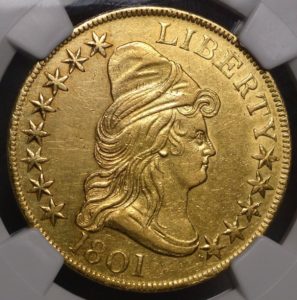Draped Bust $10 (1795-1804)
During the 18th century, Americans were only familiar with the Spanish Coins when talking about the United States’ monetary systems after the Revolutionary War.
In a bid to strike a balance between the old and new, the architects of the monetary system formulated a plan to do just that. This resulted in a new  coinage scheme for the $10 piece that was the country’s premier gold coin. Because it was intended to be America’s face to the world by the Congress Mint Act of 1792, the “eagle” was symbolically added, which is the US’ national bird.
coinage scheme for the $10 piece that was the country’s premier gold coin. Because it was intended to be America’s face to the world by the Congress Mint Act of 1792, the “eagle” was symbolically added, which is the US’ national bird.
Draped Bust $10, Small Eagle (1795-1797)
Less than two months after the half eagle first appeared, the “eagles” appeared for the first time in 1795. It was flanked by 10 stars on the left and 5 stars on the right. On the reverse side, is an eagle perched on a palm branch, with its wings spread and a crown on its beak. UNITED STATES OF AMERICA was inscribed round the coin.
- From 1795 to 1797, 13,344 eagles with the capped bust/small eagle were struck by the Philadelphia Mint. There were only three dates in the series and featured different designs.
- 1795 coins featured the rare and famous origin of the nine palm trees.
- 1796 coins have a total of 16 stars on Liberty Edge, 8 stars on either side. This marked the advent of Tennessee in the Union.
- 1797 coin have 16 stars—4 on the right and 12 on the left.
- Both the 1796 and 1797 coins had a palm tree with eleven leaves.
Among these coins, those issued in 1796 were scarcer than the coins struck in 1795.
Draped Bust $10, Heraldic Eagle (1797-1804)
In mid-1797, the Draped Bust $10, Small Eagle was replaced with the new Draped Bust $10, Heraldic Eagle. The Great Seal of the United States served as the model of the coin’s redesigned bird. Many considered this as the closest thing that the US had to a coat of arms.
It was in the summer of 1797 when the first eagles with the Heraldic appeared on the reverse side. The obverse, on the other hand, showed Liberty’s bust flanked by 6 stars to the right and 10 to the left.
In 1798, the number of stars changed to only 39 and appeared in two arrangements—9 stars on the left and 4 on the right and 7 on the left and 6 on the right.
In 1799, the arrangement of the stars became fixed—5 on the right and eight on the left.
Among the Draped Bust $10, Heraldic Eagle struck, those issued in 1799 and 1801 are often available in a mint state. Some pieces are even in superb quality.
Coins struck in 1800 are quite elusive because its circulation is less frequent. But the series in 1803 is even rarer.
The 1804 series, however, trumps every other year in rarity, exceeding in rarity only by the 1798/7 coin.
119,248 eagles were made in the Philadelphia Mint between 1799 and 1804. But the huge melts that happened throughout the early part of the 19th century resulted in the destruction of the many of the struck coins. When 1804 hit, US gold coins were melted uncontrollably.
